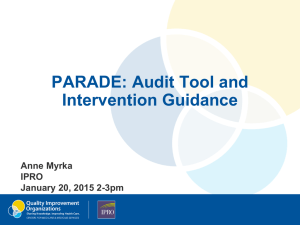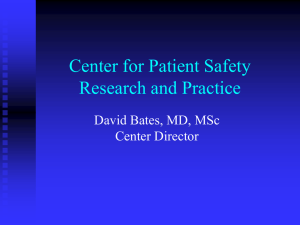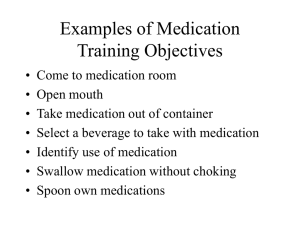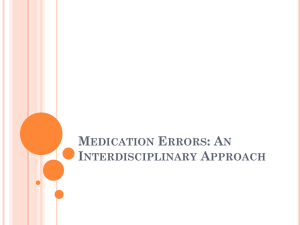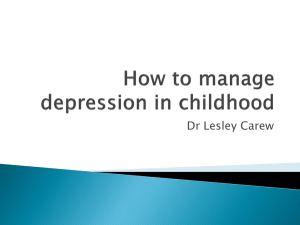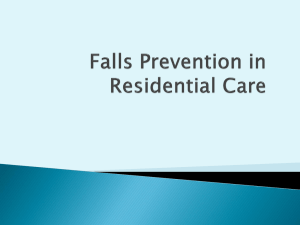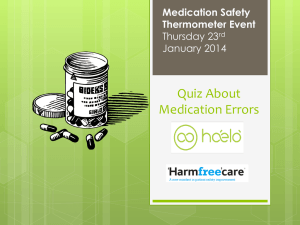Presentation Slides - Quality Improvement Organizations
advertisement
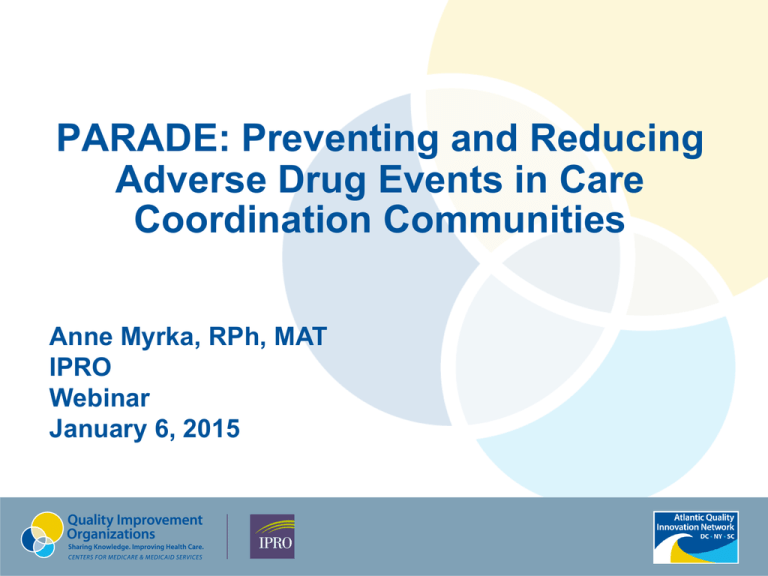
PARADE: Preventing and Reducing Adverse Drug Events in Care Coordination Communities Anne Myrka, RPh, MAT IPRO Webinar January 6, 2015 Objectives Introduce IPRO and the Centers for Medicare & Medicaid Quality Innovation Network/Quality Improvement Organization Program Provide overview of CMS 11th Scope of Work Coordination of Care task Describe the Preventing and Reducing Adverse Drug Events (PARADE) initiative Describe PARADE Objectives and Strategy Gain Cross-setting Community Commitment Establish the PARADE Timeline Next Steps, Q & A 2 IPRO The federally funded Medicare Quality Innovation Network – Quality Improvement Organization (QIN-QIO) for New York State. Under contract with the Centers for Medicare & Medicaid Services (CMS). Leading the Atlantic Quality Innovation Network (AQIN). 3 Atlantic Quality Innovation Network (AQIN) One of 14 QIN-QIOs across the country working to provide quality improvement learning opportunities, technical assistance and free resources in support of CMS healthcare quality goals. Led by IPRO in New York State. Partners include Delmarva Foundation in the District of Columbia and the Carolinas Center for Medical Excellence in South Carolina. 4 QIN-QIO Program Continued commitment to partnering with stakeholders on datadriven initiatives that increase patient safety, make communities healthier, better coordinate post-hospital care and improve clinical quality. Grounded in principles that align with the goals of the CMS Quality Strategy: Eliminating disparities, Strengthening infrastructure and data systems, Enabling local innovation, and Fostering learning collaboratives. 5 QIN-QIO Program Goals and Initiatives (2014 – 2019) Goal 1: Promote effective prevention and treatment of chronic disease by: Partnering with physicians to provide more effective treatment to patients at risk for heart attack and stroke, especially those in underserved populations. Supporting self-management education to patients with diabetes. Helping physician practices use EHRs to full potential and provide patients with preventive services. Goal 2: Make care safer and reduce harm caused in the delivery of care by: Working with providers across the continuum of care of care to prevent HAI in hospitals and other settings. Targeting prevention of HAC in nursing homes and facilitating collaboration, innovation and enhanced patient and family engagement. 6 QIN-QIO Program Goals and Initiatives (cont’d) Goal 3: Promote effective communication and coordination of care by: Helping community stakeholders, providers, patients and families to collaborate for better coordination of care transitions, improved discharge communication, and better access to community services. Sharing evidence-based approaches to reduce avoidable hospitals readmissions, especially in vulnerable populations. Working with providers and stakeholders across settings to reduce potential adverse drug events and promoting medication management strategies. Goal 4: Make care more affordable by: Helping providers report on measures that assess clinical quality of care, care coordination, patient safety and patient and caregiver experience of care and helping providers improve care quality through effective use of healthcare IT. 7 CMS 11th Scope of Work Task Priorities A Excellence in Operations Better Health QIO-QIN Essential Functions B 1. Results-Oriented Quality Improvement Activities Better Care C 2. Community Learning and Action Networks 3. Technical Assistance (i.e., Quality Improvement Experts) 4. Integrated Communications •B1. Improving cardiac health & reducing cardiac disparities •B2. Reducing disparities in diabetes care •B3. Coordinating care through Immunization Information Systems •B4. Coordinating prevention through Health Information Technology D E •C1. Reducing care-associated infections •C2. Reducing care-acquired conditions • C3. Coordinating care to reduce readmits & adverse drug events Lower Costs •D1. Quality Improvement through Physician Value Modifier •D2. Local QIO Projects Technical Assistance •BFCC-QIO, et al – Quality Improvement Initiatives •Value-Based Purchasing Coordination of Care Task Goals Promote Effective Communication and Coordination of Care Reduce hospital readmission rates in the Medicare program by 20% by 2019 Reduce hospital admissions rates in the Medicare program by 20% by 2019 Increase community tenure, as evidenced by increased number of nights spent at home, for Medicare beneficiaries by 10% by 2019 Reduce the prevalence of adverse drug events (ADEs) that contribute to significant patient harm, emergency department visits, observation stays, hospital admissions or readmissions occurring as a result of the care transitions process ● Anticoagulants ● Hypoglycemic Agents ● Opioids 9 What is IPRO’s PARADE Initiative? 10 Reducing Adverse Drug Events: Federal Alignment of Resources Anticoagulants, Opioids, Hypoglycemics: Communication failures Suboptimal management systems Inadequate access to medication lists and lab results 11 PARADE Initiative – Pilot study and results Based on an IPRO multi-facility rapid-cycle pre (February 2014) and post (July 2014) intervention quality improvement pilot study, “Medication Reconciliation and Anticoagulation Management Across Care Settings” Four Care Transitions collaboratives comprised of hospitals, skilled nursing facilities (SNFs), home healthcare agencies Evaluated the discharge communication of 17 evidencebased requisite anticoagulant-related information elements and 5 medication reconciliation processes across care settings 5 to 10 charts, retrospectively 12 PARADE Initiative – Pilot study and results Evidence-based system improvements were applied according to site-specific baseline results Results Significant improvement in communication of requisite anticoagulation-related elements to subsequent provider upon transfer/discharge: All facilities (16%, 95% CI 11.6%-20.3%) Hospitals (8%, 95% CI 1.2%-15.2%) SNFs (19%, 95% CI 12.7%- 25.8%) Significant improvement in completion of medication reconciliation processes upon admission in SNFs (21.2%, 95% CI 9.6%- 31.9%) 13 Medication Reconciliation Elements Was an original home medications list collected on admission? Did the list of original home medications collected at admission include the medication name, dose, route and frequency for each medication? (all elements for all drugs must be present for Yes) Was the original home medication list reconciled with admission orders in less than 24 hours? Did the reconciled medication list reside in a dedicated location in the medical record? Was there is a 1:1 match for every medication on the home medication list to the admitting orders? (all elements for all drugs must match for Yes) 14 Requisite Anticoagulation Management Elements Communicated at Transfer/Discharge to Subsequent Provider Was the primary indication for use of the anticoagulant clearly documented? Was an assessment of fall risk clearly documented? Anticoagulation Management Elements Communicated at Did documentation indicate whether Requisite the patient was new to anticoagulation therapy or a previous user? If new, was start date of anticoagulation therapy provided? Did documentation indicate whether treatment is intended to be acute (short term) or chronic (long term)? If acute (short term) was total duration of therapy provided? (was there a stop/end date?) Date, time, and strength of last dose given documented? (all must be present for Yes) Date, time, and strength of next dose due provided? (all must be present for Yes) If on Coumadin (warfarin), was the target INR or INR range documented? If on Coumadin (warfarin), were the last 2 INR lab results provided (with dates and results)? If on Coumadin (warfarin), was the date provided for when the next INR was due? Was the most recent serum creatinine or creatinine clearance evaluation provided (with date and results)? Was the patient provided with educational material? Was an assessment of patient/caregiver understanding of the education documented? Was documentation of patient/caregiver education and understanding communicated to the next provider? Was contact information provided for the anticoagulation management prescriber/physician? Was patient referred to an anticoagulation management service? (e.g. Coumadin/warfarin clinic) Link to audit tool: http://qio.ipro.org/drug-safety/drug-safety-resources 15 PARADE Initiative QIOs are directed by CMS in the 11th Statement of Work (11SoW) to: Establish relationships and collaborations in the community to coordinate provider communication and medication management across care settings with a patient centered focus Help providers utilize new or existing evidence-based tools and practices to improve the care of those prescribed high risk medications, specifically anticoagulants, diabetic agents and opioids Use health information technology to screen for and prevent ADEs in Medicare beneficiaries 16 PARADE Objectives and Strategy 17 PARADE Objectives To identify patients at risk of experiencing ADEs due to high risk medication use following hospital discharge To identify hospital readmissions and emergency department visits associated with high risk drug exposure To evaluate the post-discharge medication use system across care settings and identify opportunities for system improvements To facilitate the implementation and serial evaluation of evidence-based intervention strategies 18 PARADE Strategy Process measures – All facilities/healthcare providers Small, low-impact audits of medication reconciliation processes and high risk drug discharge communication (5-10 charts, retrospective) Serial evaluation to guide improvements Goal: 100% adherence to audit criteria in 6 months Interventions Evidence based interventions according to site-specific results Outcome measures – Hospitals only Readmissions due to ADEs using data from electronic health record data (hospital) and claims data (IPRO) Serial evaluation to identify improvements Goal: Demonstrate measureable improvement over 5 year scope of work 19 PARADE Strategy Based on 6 month improvement cycles Cross setting work will be achieved within each care transition coalition Medication Management Committee monthly meetings Cycle 1 is January 6, 2015 – June 30, 2015 All facilities will focus on Medication Reconciliation and Anticoagulation Discharge Communication Educational webinars on management of hypoglycemics and opioids will be provided prior to the launch of Cycle 2 (which will expand to process improvements for hypoglycemics and opioids) 20 PARADE Strategy Cycle 1 January 6, 2015 – June 30, 2015 All facilities (including those who participated in the pilot study) will complete and return a PARADE Request for Technical Assistance by January 16, 2015 Eligible facilities are hospitals, skilled nursing facilities (SNF), rehabilitation facilities, home healthcare services/agencies (HHA), residential facilities, adult homes, pharmacies (hospital, community, SNF vendors, etc.) Participating individuals are administrators, physicians, nurses, pharmacists (including SNF consultant pharmacists), quality improvement professionals, discharge planners, HHA hospital liaisons, etc. 21 PARADE Strategy Cycle 2 is July 1, 2015 – December 31, 2015 Continue to work on ADE hospital readmission measure, high risk drug discharge communication and med rec improvement processes Expand to medication management of hypoglycemics, opioids, other (e.g. antibiotics) IPRO is currently convening subject matter experts to provide guidance on best practices for management across care settings during transitions Subsequent Cycle work will focus on continued evidence based improvements, sustainability and applicable cross-setting emerging measures 22 PARADE Process Measures: Audit Methods 23 Audit Methods – Medication Reconciliation 24 Audit Methods – Medication Reconciliation 25 Audit Methods: Anticoagulation Discharge Communication (AC-DC) Audit Tool Excel version Preferred method of data collection Calculates performance statistics automatically and includes performance dashboard Color coded performance: Green = >90% of completed fields as "yes“ = 60-90% “yes” Red = <60% “yes” 26 Audit Methods – Anticoagulation Discharge Communication (AC-DC) Paper Tool Link to paper audit tool: http://qio.ipro.org/drug-safety/drug-safety-resources 27 28 Additional Ad Hoc Anticoagulation MeasureWarfarin Time in Therapeutic Range Designed for skilled nursing facilities, outpatient clinics and others that serve population over long term For more information: http://qio.ipro.org/drug-safety/collaborativepartners/analytic-services *TTR – Rosendaal’s method 29 PARADE Interventions 30 Interventions Policy & Procedure improvements Educational programs Clinical tools & resources Monthly networking/collaboration through each Coalitions’ Medication Management Committee meetings 31 Medication Reconciliation Intervention Resources http://www.hospitalmedicine.org/marquis/ 32 Medication Reconciliation Intervention Resources http://www.ahrq.gov/professionals/quality-patientsafety/patient-safety-resources/resources/match/index.html 33 Medication Reconciliation Improvement Tools 34 Anticoagulation Management Evidence Based Resources The Anticoagulation Centers of Excellence: http://acforumexcellence.org/ 35 http://qio.ipro.org/drug-safety/drug-safety-resources Anticoagulation Improvement Tools 37 PARADE Outcome Measure 38 Outcomes: ADE Surveillance Process Hospitals All patients possessing the following elements at time of hospital discharge: • ≥ 3 medications ordered in total, and; • Anticoagulant • Opioid • Hypoglycemic •How? EHR query • Patient identifier - SSN and MRN • Drugs - can be identified using drug name text string files provided by IPRO • Raw data files transferred to IPRO via secure data transfer protocol • Denominator Raw Numerator All patients identified in Denominator with Emergency Department Visit or Hospital Re-admission within 30 days •How? IPRO analysis of Medicare Part A data • Final Verified Numerator • Determination of presence of ADE by Root Cause Analysis • How? CDC abstraction tool verified for anticoagulants, opioids, and hypoglycemic ADEs. Preventable ADEs targeted for coalition-wide evidence based intervention(s). 39 Baseline measure completion date will be individualized per hospital Remeasure quarterly after baseline is completed Secure data transfer protocol utilized Commitments, Timeline, and Due Dates 40 Organization/Provider Commitments IPRO’s strategy requires creation of a local ADE-specific collaborative comprised of at least one hospital and two or more downstream providers committed to sharing information and working across settings to successfully complete the work. Participants will: Join your local cross-setting IPRO supported Community Care Transitions Coalition by signing on to its Coalition Charter Establish an internal team to share project responsibility for your organization Commit to collaborate with IPRO for duration of the project; agree to investigate adverse drug events and address performance outliers as part of the quality improvement plan Commit to developing and implementing a sustainable quality improvement plan to address identified deficiencies Implement and evaluate the impact of one or more intervention strategies Attend and actively participate in the Medication Management Committee convened within your community’s Care Transition Coalition and attend IPRO coaching support calls as needed 41 IPRO Commitments Provide technical assistance to support serial data collection, analysis, and reporting Perform analysis of prescription drug data at baseline and quarterly over each 6 month ADE improvement interval (hospitals) Provide detailed reports characterizing at-risk population and suspected ADEs Facilitate interpretation and root cause analysis to identify priorities for intervention Lead the Medication Management Committee for the Community Coalition and facilitate communications between partner providers Provide evidence-based clinical tools and educational resources for quality improvement interventions Assist in determining effectiveness of interventions and support innovative strategies that sustain safety goals 42 Commitments, Request for Technical Assistance and Completion Date Due: January 16, 2015 43 PARADE Cycle 1 Timeline and Due Dates Date/Time January 6, 2015, 2-3pm January 16, 2015 January 20, 2015, 2-3pm January 22, 2015, 2-3pm January and monthly thereafter February 6, 2015 February and March March 17, 2015, 2-3pm March 30, 2015 April May 30, 2015 June Topic/Activity PARADE Project Launch Webinar Technical Assistance Request Due Date; AC-DC Excel tool will be emailed to participating facilities Webinar: PARADE Measures and Audit tool guidance and Q&A Webinar: Reducing Hypoglycemic Events in the Elderly – Dr. Medha Munshi Each Coalition has monthly Med Management Committee Meetings to advance work Baseline audits due; IPRO analysis of baseline audit sent to facilities within 2 weeks Coalition Med Management Committee Meetings – interventions/prioritization Coaching Call; teleconference only: 1-877-287-8135 *8949321* Remeasure due; IPRO analysis of remeasure sent to facilities within 2 weeks Coalition Med Management Committee Meetings Remeasure due; IPRO analysis of remeasure sent to facilities within 2 weeks Coalition Med Management Committee Meetings Review initial 6 month cycle outcomes; create plan for continuing improvements and sustainability; expand to 44 hypoglycemic, opioids 45 Summary & Next Steps PARADE Request for Technical Assistance Agreement due by January 16, 2015 SAVE the DATE - Webinar: January 20, 2015 2-3pm – audit tool guidance, Q&A Audits: Excel AC-DC audit tool (preferred) will be emailed to facilities after technical agreement is signed Paper AC-DC audit tool can be utilized Med rec audit – only paper tool is available Fax completed paper audits by due dates to Anne at: 518-426-3418 Email completed Excel AC-DC tool by due dates to Anne at: anne.myrka@hcqis.org Outcome ADE readmission baseline completion date will be individualized per hospital 46 Collaborative Disclosures Project is designed to encourage collaboration Through that effort we will facilitate the sharing of facility names, team members and email addresses with all involved in project We will not share your individual QI findings or QI data with any other organization without your consent Please contact Anne by January 16, 2015 if you do NOT wish to have your contact information shared 47 Questions / Feedback 48 For more information Anne Myrka Pharmacist – Drug Safety (518) 320-3591 Anne.Myrka@hcqis.org Sara Butterfield Senior Director – Care Coordination (518) 320-3504 Sara.Butterfield@hcqis.org Darren Triller Senior Director – Drug Safety (518) 320-3525 Darren.Triller@hcqis.org IPRO Care Transitions Web Site: http://qio.ipro.org/care-transitions/overview IPRO CORPORATE HEADQUARTERS IPRO Drug Safety Web Site: http://qio.ipro.org/drug-safety/overview 1979 Marcus Avenue Lake Success, NY 11042-1002 IPRO REGIONAL OFFICE 20 Corporate Woods Boulevard Albany, NY 12211-2370 www.atlanticquality.org This material was prepared by the Atlantic Quality Innovation Network/IPRO, the Medicare Quality Innovation Network Quality Improvement Organization for New York State, South Carolina, and the District of Columbia, under contract with the Centers for Medicare & Medicaid Services (CMS), an agency of the U.S. Department of Health and Human Services. The contents do not necessarily reflect CMS policy. 11SOW-AQINNY-TskC.3-14-23
